Standing at the threshold of my own home renovation journey three years ago, I never imagined how much a single element could transform an entire property’s character. As I watched my neighbor install what looked like a masterpiece carved from wrought iron, I realized that driveway gate ideas weren’t just about security or functionality—they were about making a statement that whispers your story before you even open your front door.
That moment sparked an obsession that led me down rabbit holes of architectural history, conversations with master craftsmen, and countless hours studying how the world’s most stunning homes create their first impressions. What I discovered changed everything I thought I knew about home design: your driveway gate isn’t just an entrance, it’s the opening chapter of your home’s narrative.
The statistics tell a compelling story too. According to the National Association of Realtors, well-designed exterior features can increase property value by up to 15%, with distinctive entry elements being among the most impactful investments homeowners can make. But beyond the numbers lies something more profound—the psychological impact of crossing through a beautiful threshold that transitions you from the public world into your private sanctuary.
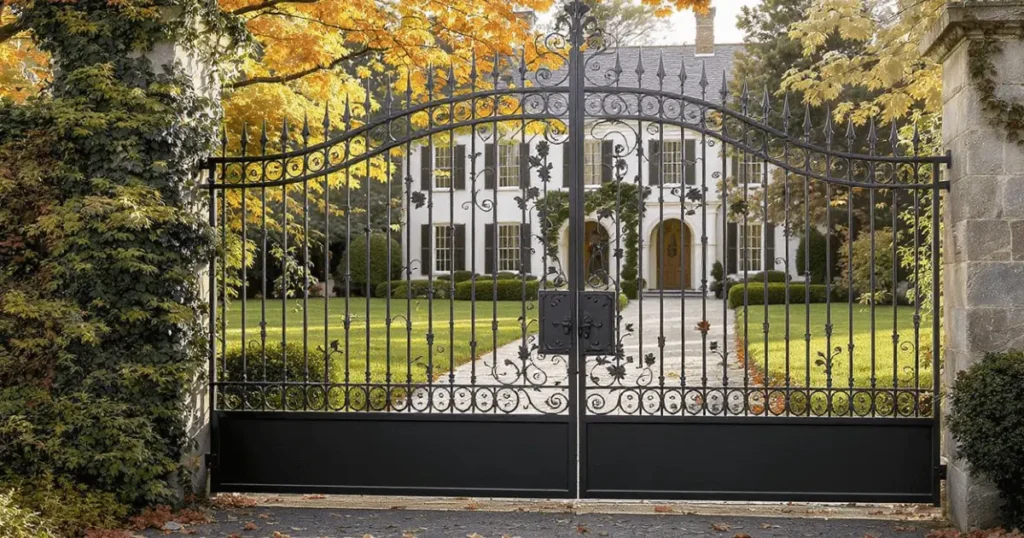
The Psychology Behind Picturesque Entries
Before diving into specific decorative driveway gates, let’s explore why these artistic elements resonate so deeply with us. Environmental psychology research from the University of Utah suggests that the transition spaces in our built environment—like gateways—significantly influence our emotional state and sense of place. When we pass through a thoughtfully designed entry, our brains register the shift from public to private space, creating what researchers call a “psychological decompression zone.”
This isn’t just academic theory. I’ve witnessed it firsthand when visiting homes with stunning custom gate designs. There’s an almost ceremonial quality to passing through a beautiful gate—a moment where the outside world falls away and you’re welcomed into someone’s carefully curated realm.
Dr. Sally Augustin, an environmental psychologist and author of “Place Advantage,” explains that artistic elements in our immediate environment trigger positive emotional responses that can reduce stress and increase feelings of well-being. When applied to driveway entrances, this principle transforms a purely functional element into a daily dose of beauty that greets you each time you come home.
Artistic Driveway Gate Ideas That Inspire
So, here are the 10 artistic driveway gate ideas that have captivated me throughout my journey of discovery. Each represents a different approach to transforming your entrance from merely functional to genuinely inspiring. I’ve personally encountered variations of these designs in my travels, and what makes them special isn’t just their visual appeal—it’s how they make you feel when you experience them. From traditional craftsmanship that honors centuries-old techniques to cutting-edge innovations that push the boundaries of what’s possible, these gate concepts offer something for every architectural style and personal taste.
1. The Whimsical Wrought Iron Wonder
My first encounter with truly artistic wrought iron gate ideas happened during a walking tour through Charleston’s historic district. There, nestled between centuries-old oak trees, stood a gate that seemed to tell stories through its metalwork. Intricate vines wound around vertical bars, with delicate leaves that appeared to flutter in the breeze despite being crafted from solid iron.
Wrought iron driveway gates offer unparalleled versatility in artistic expression. The malleability of heated iron allows craftsmen to create flowing, organic designs that seem to grow naturally from the landscape. Traditional motifs include botanical elements like roses, grape vines, and oak leaves, while contemporary designs might feature abstract geometric patterns or even personalized family crests.
What makes wrought iron particularly appealing is its ability to balance security with beauty. According to the Iron and Steel Institute, properly treated wrought iron can last over 100 years with minimal maintenance, making it both an artistic and practical investment. The patina that develops over time actually enhances the visual appeal, creating a living finish that evolves with your home.
When considering a wrought iron installation, work with craftsmen who understand the historical techniques. Master blacksmith Tom Joyce, whose work is featured in the Smithsonian American Art Museum, emphasizes that authentic wrought iron work requires understanding the material’s grain structure and working with, rather than against, its natural properties.
2. Contemporary Geometric Steel Masterpieces
The modern driveway gate styles I encountered during my research in Silicon Valley represented a complete departure from traditional designs. Instead of curves and organic forms, these contemporary entry gates featured bold geometric patterns that seemed to slice through space with mathematical precision.
One particular installation caught my attention—a series of intersecting rectangles in varying sizes that created an optical illusion of depth and movement. The powder-coated steel maintained its crisp lines while the spacing between elements allowed glimpses of the landscape beyond, creating what architects call “controlled revelation.”
Contemporary steel gates often incorporate principles from the Bauhaus movement, emphasizing form following function while celebrating the material’s inherent properties. The International Association of Architectural Metal Craftsmen notes that modern steel fabrication techniques allow for incredibly precise tolerances, enabling designs that would have been impossible just decades ago.
These modern designs work particularly well with mid-century and contemporary architecture. The clean lines complement the horizontal emphasis of ranch-style homes, while the geometric patterns can echo architectural details found in the main structure. Landscape architect Miranda Brooks, whose work has been featured in Architectural Digest, suggests that geometric gates work best when they create a visual dialogue with existing architectural elements rather than competing with them.
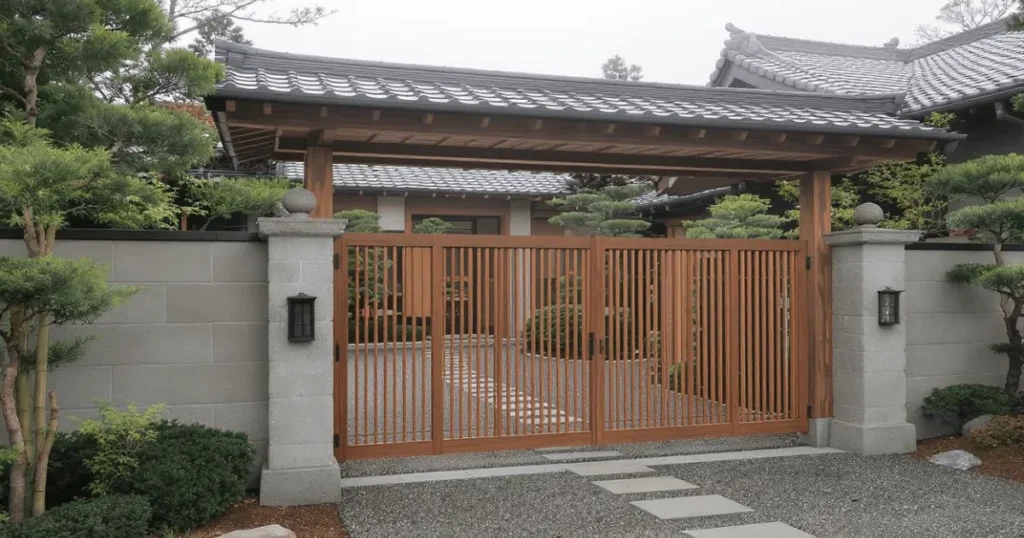
3. Rustic Wooden Charm with Character
There’s something deeply satisfying about wooden driveway gates that speaks to our connection with natural materials. During my visit to a craftsman’s workshop in Vermont, I watched him select each board for a custom gate, examining the grain pattern like a sommelier studying wine. The result was a gate that seemed to have grown rather than been built.
Wood offers unique opportunities for artistic expression through both construction technique and natural variation. Reclaimed barn wood carries history in its weathered surface, while carefully selected cedar or redwood provides rich color and natural resistance to decay. The key to successful wooden gate design lies in understanding how different species age and weather.
According to research published in the Journal of Wood Science, properly constructed wooden gates using traditional joinery techniques can last 50-75 years even in challenging climates. The secret lies in allowing the wood to move naturally with seasonal changes while maintaining structural integrity.
Master woodworker Sam Maloof, whose furniture pieces are held in museum collections worldwide, always emphasized that wood has its own voice. This philosophy applies beautifully to gate design—the most successful wooden gates work with the material’s natural characteristics rather than trying to impose artificial constraints.
Consider incorporating traditional joinery techniques like mortise and tenon construction, which creates incredibly strong connections without relying entirely on metal hardware. The visible joinery becomes part of the aesthetic appeal, showcasing the craftsman’s skill while honoring time-tested construction methods.
4. Living Architecture: Gates with Integrated Landscaping
The concept of living gates first captured my imagination during a visit to the famous gardens at Longwood in Pennsylvania. There, I encountered gates that seemed to dissolve into their surroundings, with climbing vines integrated into the structure and planters built directly into the framework.
These artistic metal gates serve dual purposes—they provide the expected security and definition while also functioning as vertical gardens. The integration of plant life softens the hard edges of metal or wood, creating a more organic transition between spaces. Over time, as plants mature and fill out the structure, the gate becomes increasingly integrated into the landscape.
Successful living gate design requires careful plant selection based on your climate zone and maintenance preferences. Evergreen vines like English ivy or jasmine provide year-round coverage, while deciduous options like grape vines offer seasonal variation. The American Society of Landscape Architects recommends choosing plants that complement your local ecosystem and don’t require excessive water or maintenance.
One particularly striking example I documented featured a steel framework with integrated planter boxes at varying heights. Fast-growing bamboo provided quick privacy, while slower-growing flowering vines added color and fragrance. The result was a gate that changed character throughout the seasons, providing an ever-evolving entrance experience.
5. Water Feature Integration
During my research, I discovered that some of the most memorable creative gate designs incorporated water elements. One installation in Arizona featured a gate with integrated misting nozzles that created a cooling effect in the desert climate while adding the soothing sound of running water.
Water integration can range from simple drip features that create subtle sounds to elaborate fountain systems built into gate pillars. The key is ensuring that water elements enhance rather than overwhelm the overall design. Landscape architect Peter Walker, known for his innovative water features, suggests that successful integration requires understanding how water behaves in different weather conditions and seasons.
The maintenance considerations for water-integrated gates are significant but manageable with proper planning. Frost-proof plumbing, accessible shut-off valves, and appropriate drainage all factor into successful long-term operation. The investment in infrastructure pays dividends in creating a truly unique entrance experience that engages multiple senses.
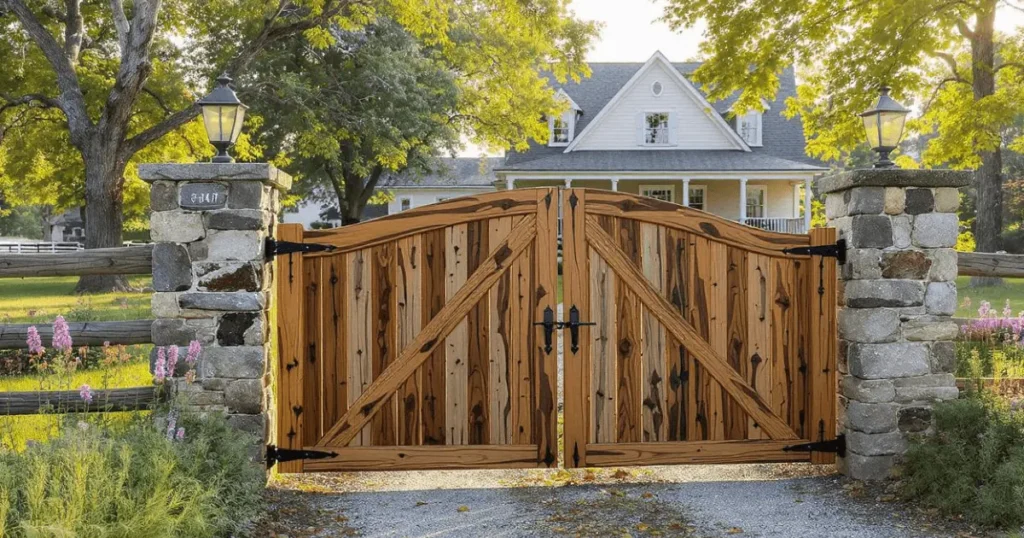
6. Smart Technology Meets Artistry
The evolution of automated driveway gates has opened new possibilities for artistic expression while providing enhanced convenience and security. Modern electric driveway gates can incorporate sophisticated control systems while maintaining beautiful aesthetics.
I was fascinated to learn about gates that respond to smartphone apps, allowing homeowners to open their entrance from anywhere in the world. Some systems include integrated cameras and intercom features, effectively turning the gate into a high-tech welcome center. The Security Industry Association reports that residential gate automation has grown by 25% annually over the past five years, driven largely by improved reliability and decreased costs.
The artistic challenge lies in hiding the technology within beautiful design. The most successful installations bury wiring underground, conceal motors within gate posts, and integrate control panels seamlessly into the overall aesthetic. LED lighting systems can be programmed to create dramatic effects while providing practical illumination for evening arrivals.
7. Cultural and Historical Inspirations
Some of the most compelling stylish home entrance gates draw inspiration from specific cultural traditions or historical periods. During my travels, I’ve encountered gates inspired by Japanese minimalism, featuring clean lines and natural materials that create serene, Zen-like entrances.
Mediterranean-inspired designs often incorporate curved archways, decorative tile work, and wrought iron scrollwork that evokes the romantic architecture of Southern Europe. These gates work particularly well in warm climates where outdoor living is emphasized year-round.
The key to successful cultural interpretation lies in understanding the underlying principles rather than simply copying surface details. Japanese design emphasizes harmony with nature and the beauty of imperfection, while Mediterranean styles celebrate craftsmanship and the interplay of light and shadow.
Research by architectural historian Spiro Kostof suggests that the most enduring architectural elements are those that adapt universal human needs to specific climatic and cultural conditions. This principle applies beautifully to gate design—the most successful installations feel both timeless and perfectly suited to their specific context.
8. Sculptural Statement Pieces
During a visit to an art collector’s home in Santa Fe, I encountered a gate that was unmistakably a work of sculpture first and functional barrier second. Created by a local metal artist, the piece featured abstract forms that cast intricate shadows throughout the day, creating an ever-changing display of light and pattern.
These unique front gate ideas blur the line between functional architecture and fine art. They often incorporate non-traditional materials like Corten steel, which develops a beautiful rust patina over time, or bronze elements that acquire a natural verdigris finish.
Commissioning sculptural gates requires finding artists who understand both aesthetic principles and structural requirements. The gate must function reliably while making a bold artistic statement. This balance requires careful collaboration between artist, engineer, and client to ensure that creative vision doesn’t compromise practical function.
The investment in sculptural gates often pays dividends beyond property value enhancement. These pieces become talking points and landmarks that help define neighborhood character. According to the Americans for the Arts organization, well-placed public and semi-public art installations contribute to community identity and property values in measurable ways.
9. Sustainable and Eco-Friendly Designs
Growing environmental awareness has sparked innovation in eco-friendly gate design. I’ve encountered installations using reclaimed materials, solar-powered operation systems, and designs that actively support local ecosystems.
One particularly impressive example featured a gate constructed entirely from reclaimed steel and wood, with integrated bee houses built into the supporting posts. The design provided habitat for native pollinators while creating a beautiful entrance that told the story of the homeowners’ environmental values.
Solar-powered gate operators have become increasingly practical as battery technology improves. Modern systems can operate for weeks on stored solar energy, making them practical even in climates with limited sunshine. The National Renewable Energy Laboratory has documented significant improvements in solar gate system reliability over the past decade.
Low-maintenance gates using naturally weather-resistant materials like cedar, teak, or weathering steel reduce the need for chemical treatments and frequent refinishing. These materials develop beautiful patinas over time while requiring minimal intervention to maintain their appearance and function.
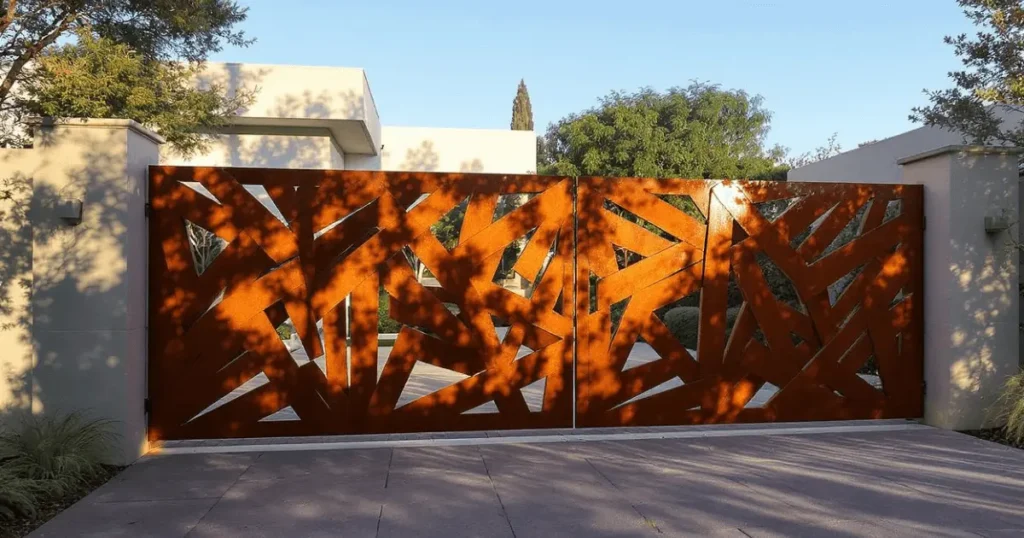
10. Mixed Media Masterpieces
The most innovative elegant gate styles I’ve encountered combine multiple materials and techniques to create truly unique installations. One memorable example featured a steel framework with wood infill panels, glass inserts, and integrated stone elements that seemed to grow from the driveway itself.
Mixed media approaches allow designers to optimize each material for its best qualities while creating visual interest through contrast and harmony. Steel provides strength and precise lines, wood adds warmth and texture, glass offers transparency and light play, while stone anchors the design to the landscape.
Successful mixed media gates require careful attention to how different materials expand and contract with temperature changes. Proper design accommodates these movements without compromising structural integrity or aesthetic appeal. The American Institute of Architects has published guidelines for multi-material construction that apply directly to gate design.
Choosing the Right Design for Your Home
After exploring countless gate installations, I’ve learned that the most successful projects begin with honest assessment of your home’s architectural style, your family’s lifestyle needs, and your local climate conditions. The goal isn’t to create the most elaborate gate possible, but rather to design an entrance that feels like a natural extension of your home’s character.
Consider your daily routine—do you need quick access for multiple vehicles, or is your gate primarily for weekend use? Think about maintenance preferences—are you excited about the prospect of seasonal upkeep, or do you prefer set-it-and-forget-it solutions? Factor in your local climate—materials that thrive in coastal environments may struggle in desert conditions.
Security needs vary dramatically between urban and rural settings. Consult with local contractors who understand regional requirements and can suggest appropriate solutions. The American Fence Association maintains databases of certified installers who can provide guidance specific to your area.
Installation and Maintenance Considerations
Professional installation is crucial for both safety and longevity. Gates are complex mechanical systems that must function reliably while withstanding significant environmental stresses. Improper installation can lead to premature failure, safety hazards, and frustrating operational problems.
Quality installations include proper foundation work, accurate alignment, and appropriate drainage. Automated systems require electrical work that meets local codes and safety standards. Most manufacturers void warranties if installation isn’t performed by certified technicians.
Regular maintenance schedules vary by material and complexity. Simple hinged gates may need only annual lubrication and inspection, while automated systems benefit from quarterly professional service. Establish maintenance relationships with qualified technicians before you need emergency repairs.
Investment and Return Considerations
Gate installations represent significant investments that can range from several thousand dollars for basic designs to tens of thousands for elaborate custom work. The National Association of Realtors data suggests that distinctive exterior improvements typically return 60-80% of their cost in increased property value, with unique installations often commanding premium returns.
Consider the long-term value proposition beyond simple cost recovery. A well-designed gate enhances daily living experience, provides security and privacy benefits, and can significantly reduce maintenance requirements compared to traditional fencing solutions.
Financing options for major gate installations include home improvement loans, which often offer favorable terms for projects that increase property value. Some contractors offer payment plans for custom work, allowing you to spread costs over the construction timeline.
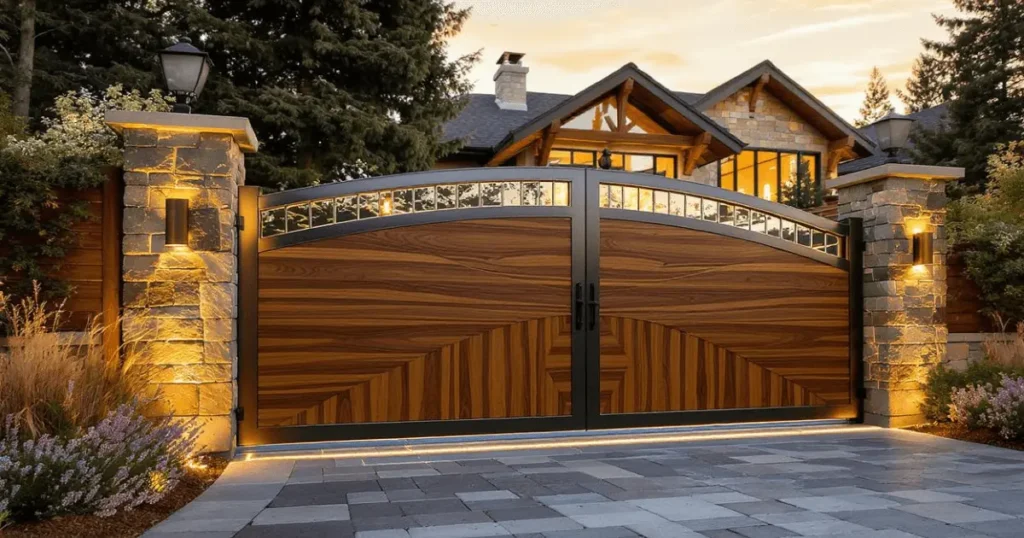
Conclusion: Your Gateway to Transformation
Standing here at the end of our journey through these artistic driveway gate ideas, I’m reminded of that transformative moment three years ago when I first understood the power of a thoughtfully designed entrance. Each gate we’ve explored represents more than just a barrier or decoration—they’re portals that frame your daily transition between public and private worlds.
The wrought iron masterpieces whisper stories of Old World craftsmanship, while contemporary steel designs declare bold visions of the future. Wooden gates connect us to nature’s rhythm, and living installations blur the boundaries between architecture and landscape. Smart gates embrace technology without sacrificing beauty, while sculptural pieces elevate function to art.
What strikes me most profoundly is how these durable gate materials and innovative designs reflect our deepest desires for home. We want beauty that endures, security that doesn’t compromise aesthetics, and entrances that welcome us back to our home each day. Whether you’re drawn to the timeless elegance of wrought iron, the clean lines of modern steel, or the warm embrace of natural wood, your choice will become part of your home’s story for decades to come.
The investment in a truly artistic gate extends far beyond curb appeal enhancements or property value increases. You’re creating a daily ritual of beauty, a moment of transition that honors both where you’ve been and where you’re going. Every time you pass through your carefully chosen entrance, you’re reminded that home isn’t just a place—it’s a feeling, and it begins the moment you cross that threshold.
Your perfect gate is waiting to be discovered, whether it’s hiding in traditional craftsmanship techniques or emerging from cutting-edge design innovations. The question isn’t whether you can afford to invest in an artistic entrance—it’s whether you can afford not to create that daily moment of beauty that welcomes you home.
Disclaimer: The information and insights shared in this article are based on extensive research, industry publications, expert interviews, and personal observations from visiting numerous gate installations. While every effort has been made to provide accurate and up-to-date information, individual circumstances vary significantly. Always consult with qualified professionals, local building authorities, and manufacturer specifications before making final design and installation decisions. Building codes, material performance, and best practices may vary by location and change over time.
Also read – Heartfelt Hellos: DIY Welcome Signs For Porch To Greet Your Guests In Style
Frequently Asked Questions
Q.1 – How much does it cost to build a gate?
- Wood: The price of a manual wood gate can range from $400 to $4,000. Wood gates that are automated run from $850 to $8,500.
- Chain-link: The price range for chain-link fence gates is $200 to $1,000.
- Iron: The price range for wrought-iron gates is $600 to $8,500, with manual gates being less expensive than mechanized gates.
Q.2 – Is a sliding gate better than a swing gate?
Because they are more difficult to pry open and act as a stronger deterrent, sliding gates may provide increased security. Because sliding gates open horizontally as opposed to inside, they also maximize available areas. However, swing gates might be a better solution and require less maintenance depending on the installation space that is available.
Q.3 – Should a driveway gate open in or out?
Gates that open inward toward a property are typically thought to be more hospitable. You might not have the space or wish to incur the higher installation expenses of an automated gate since sliding gates require space on both sides of the gate entrance.
Q.4 – Can you put a gate on concrete?
This is a fairly common question that we get asked a lot, especially when customers are doing landscaping projects or DIY fencing or gate renovations. The short response is that fencing and gates can be installed into concrete or brick pavers without a doubt.
Q.5 – What is the most secure type of gate?
The ideal kind of security gate will depend on the particular demands and specifications of your organization. For business buildings, automated barrier systems are usually the safest choice; for residential structures, chain-link fences or wrought iron gates work well.
*Images used in this blog post article are for illustrative purposes only. We do not possess any copyrights to these images unless explicitly mentioned.

Nikhil Shukla
About The Author
Nikhil, with a background in Technology, is deeply passionate about Interior Design and Home Décor. At Cherry Hills Home Living, he channels this passion into creating inviting and stylish living spaces. With a unique blend of analytical thinking and creative flair, Nikhil offers innovative ideas, practical tips, and inspiring guidance to help others transform their homes into cozy retreats.